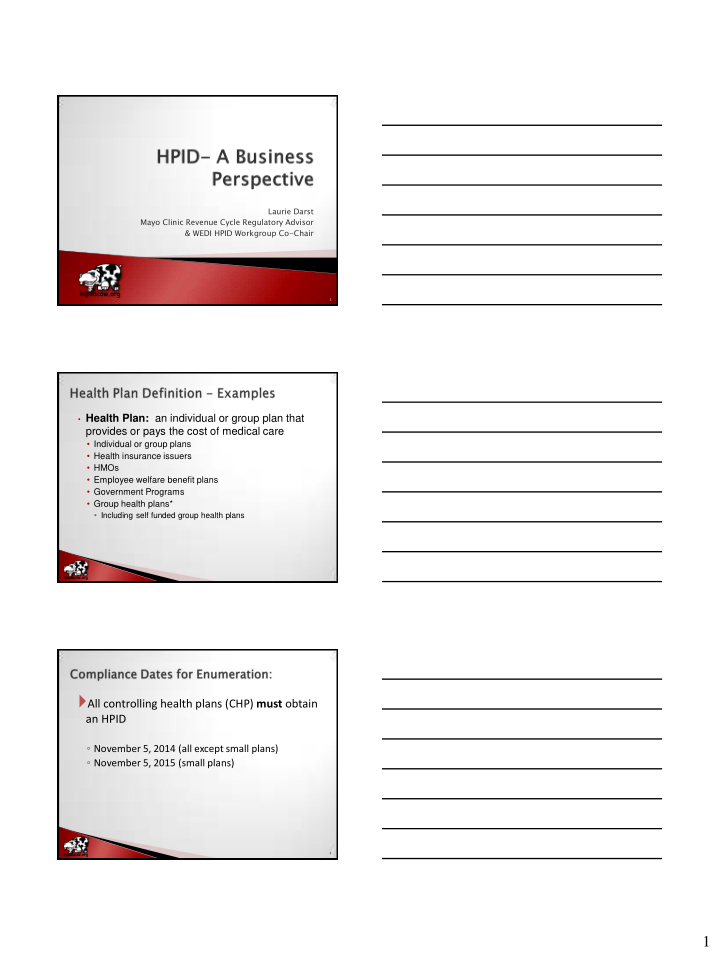



Laurie Darst Mayo Clinic Revenue Cycle Regulatory Advisor & WEDI HPID Workgroup Co-Chair 1 • Health Plan: an individual or group plan that provides or pays the cost of medical care • Individual or group plans • Health insurance issuers • HMOs • Employee welfare benefit plans • Government Programs • Group health plans* • Including self funded group health plans All controlling health plans (CHP) must obtain an HPID ◦ November 5, 2014 (all except small plans) ◦ November 5, 2015 (small plans) 3 1
Controlling health plan (CHP) A health plan that controls ◦ Its own business ◦ Its own actions ◦ Its on policies, or ◦ Is controlled by an entity that is not a health plan • Required to obtain an HPID Subhealth Plan (SHP ) A health plan whose business activities, actions or policies are directed by a CHP • Eligible, not required to obtain an HPID • Health Plan and Other Entity Enumeration Systems (HPOES) • Housed within CMS’ Health Insurance Oversight System • https://portal.cms.gov/ • Work with your Legal Area • Consider internal business needs • Consider external impacts • Consider potential impact of the impending certification rule • Make sure to enumerate before November 2014 2
On or before November 7, 2016 If you identify a health plan in a covered transaction, you must begin using the HPID as the identifier If you do not identify a health plan in a covered transaction, then you do not have to begin using the HPID HPID may be used for any other lawful purpose We have a definition from CMS on Health Plan However, the health care industry tends to use the terms ‘health plan’ and ‘payer’ synonymously CMS does not use the term ‘payer’ and has no definition for this term The majority of the instructions in the TR3s use the term ‘payer ’ The industry currently routes all transactions using a “payer id”. Moving from a ‘payer id’ routing process to a HPID (and payer id) routing process could cause significant work and risk for the industry Health plans who plan to use HPIDs in the transactions will need to contact all their providers and clearinghouses/vendors to communicate their new enumeration schema CMS has indicated the HPOES database will not be made available to the industry, at least initially Based on enumeration schemas, there may be many more HPIDs enumerated compared to one Payer ID 3
Providers will need to update their practice management systems with HPID mapping to their insurance masters Clearinghouses will need to convert payer ids to HPIDs Routing, editing, reports, and billing Misrouted claims/transaction could cause a significant privacy risk Significant multi-stakeholder resources will be required in order to use the HPID in transactions No perceived benefit to the industry – only cost WEDI’s main recommendation to CMS: require enumeration, but do not require use in the transactions What does the term ‘payer’ mean to the industry and how does that impact the use of payer id and HPID in the transactions? WEDI and X12 are working together to define the term ‘payer’ CMS Comments: If you identify a health plan in a covered transaction, you must begin using the HPID as the identifier If you do not identify a health plan in a covered transaction, then you do not have to begin using the HPID 4
Health Plans should enumerate their CHPs and SHPs prior to November 2014 (or November 2015 if small health plan) Watch for further information on the definition of ‘payer’ and how that may impact usage in the transactions If a health plan decides they are going to identify themselves as a health plan in the transactions, determine how you plan to communicate your HPID to all other stakeholders Other stakeholders should determine how they will handle HPID information CMS HPID Website http://www.cms.gov/Regulations-and- Guidance/HIPAA-Administrative- Simplification/Affordable-Care-Act/Health- Plan-Identifier.html -HPOES User Manual, HPID application process CMS eHealth Website http://www.cms.gov/eHealth/ -eHealth University, blogs, other resources 14 5
Recommend
More recommend